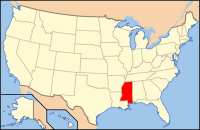Jones County, MS
| Jones County, Mississippi | |
|---|---|

Jones County courthouse in Ellisville
|
|
 Location in the U.S. state of Mississippi |
|
 Mississippi's location in the U.S. |
|
| Founded | 1826 |
| Named for | John Paul Jones |
| Seat | Laurel and Ellisville |
| Largest city | Laurel |
| Area | |
| • Total | 700 sq mi (1,813 km2) |
| • Land | 695 sq mi (1,800 km2) |
| • Water | 4.9 sq mi (13 km2), 0.7% |
| Population (est.) | |
| • (2015) | 68,215 |
| • Density | 98/sq mi (38/km²) |
| Congressional district | 4th |
| Time zone | Central: UTC-6/-5 |
Jones County is a county located in the southeast portion of the U.S. state of Mississippi. As of the 2010 census, the population was 67,761. Its county seats are Laurel and Ellisville.
Jones County is part of the Laurel, MS Micropolitan Statistical Area.
Less than a decade after Mississippi became the country's 20th state, settlers organized this area of 700 sq mi (1,800 km2) of pine forests and swamps for a new county in 1826. They named it Jones County after John Paul Jones, the early American Naval hero who rose from humble Scottish origin to military success during the American Revolution.
Ellisville, the county seat, was named for Powhatan Ellis, a member of the Mississippi Legislature who claimed to be a direct descendant of Pocahontas. During the economic hard times in the 1830s and 1840s, there was an exodus of population from Southeast Mississippi, both to western Mississippi and Louisiana in regions opened to white settlement after Indian Removal, and to Texas. The slogan "GTT" ("Gone to Texas") became widely used.
Jones County was in an area of mostly yeomen farmers and lumbermen, as the pine forests, swamp and soil were not easily cultivated for cotton. In 1860, the majority of white residents were not slaveholders. Slaves made up only 12% of the total population in Jones County in 1860, the smallest percentage of any county in the state.
Soon after the election of Abraham Lincoln as United States president in November 1860, slave-owning planters led Mississippi to join South Carolina and secede from the Union in January 1861. These were the two states with the largest holdings of slaves. Other Southern states would follow suit.
As Mississippi debated the secession question, the inhabitants of Jones County voted overwhelmingly for the anti-secessionist John Hathorne Powell, Jr. In comparison to the pro-secessionist J.M. Bayliss, who received 24 votes, Powell received 374. But, at the Secession Convention, Powell voted for secession. Legend has it that, for his vote, he was burned in effigy in Ellisville, the county seat.
...
Wikipedia
